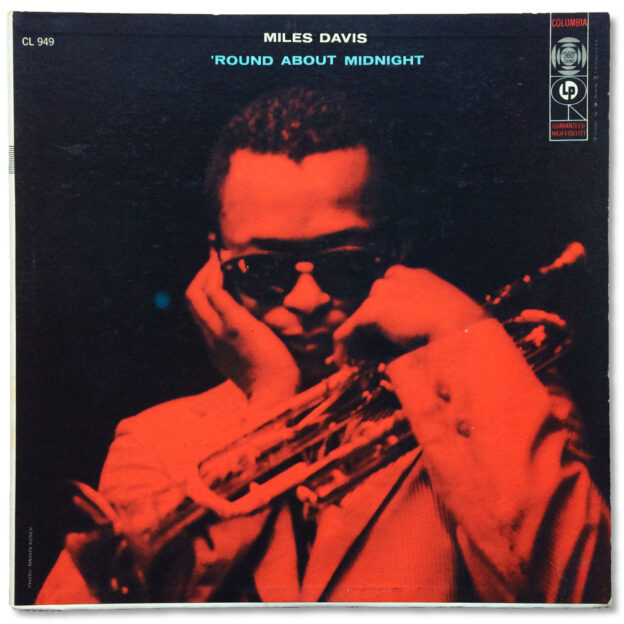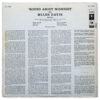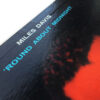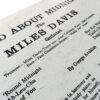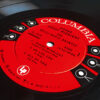- Original 1957 pressing
- “Six-eye” labels
- Deep groove on both sides
Personnel:
- Miles Davis, trumpet
- John Coltrane, tenor saxophone
- Red Garland, piano
- Paul Chambers, bass
- Philly Joe Jones, drums
All tracks recorded at Columbia 30th Street Studio, New York, NY
“Ah-Leu-Cha” recorded October 26, 1955
“Bye Bye Blackbird”, “Tadd’s Delight”, “Dear Old Stockholm” recorded June 5, 1956
“‘Round Midnight”, “All of You” recorded September 10, 1956
Originally released March 1957
Selections:
“Bye Bye Blackbird”
“Tadd’s Delight”
For Collectors
Technically the third copy of this I’ve owned, my first copy was acquired on eBay, overpriced, and in rough shape. The second wasn’t much better, but this copy, acquired at the WFMU Record Fair in New York City a few years ago for a very reasonable price, is in fantastic condition, as you will hear!
Original pressing all around — I don’t personally get caught up in the matrix code game. For labels like Columbia, a matrix code can be used to identify the stamper and other metal parts used to press a particular copy of an album. The idea is that the quality of these parts deteriorates to some degree as each part is used in the manufacturing process, and thus that copies fashioning lower part numbers in the inner run-out section of each side have the potential to sound better (for more info on the vinyl manufacturing process, check out Deep Groove Mono’s links page).
From the information I’ve gathered, however, this difference will typically be so minuscule that it would be difficult to hear the difference between two records made from different parts (provided both copies were sourced from the same master lacquer disk). This is why I’ve chosen to stay away from the matrix code melee. In any event, for all you stamper geeks out there, this particular copy of Miles Davis’ classic ‘Round About Midnight was made from a “1C” stamper for side 1 and a “1A” stamper for side 2.
For Music Lovers
“The First Great Miles Davis Quintet” would have begun formulating around spring 1955 when pianist Red Garland and drummer Philly Joe Jones first joined the trumpeter for a recording session at Van Gelder Studio in Hackensack, New Jersey (The Musings of Miles, Prestige 7014). A few months later, bassist Paul Chambers and the harmonically curious yet ever-precise tenor saxophonist John Coltrane would complete the combo.
In addition to leading his new band, Miles was simultaneously eager to make the move from Prestige to Columbia Records. But the rising star still owed Prestige label head Bob Weinstock four more albums under contract. So before Columbia could release any material under the Davis moniker, Miles would need to fulfill his agreement with Weinstock. What then commenced in 1956 for the newborn quintet was a mash-up of Prestige and Columbia dates, all of which have since been heralded as classics.
‘Round About Midnight, Davis’ Columbia Records debut, was recorded in three sessions between October 1955 and September 1956 at Columbia’s historic 30th Street Studio in New York City. Many of you will already be familiar with the legendary sound of this studio. I find the sound on this particular album to be more immediate and up-front than the roomier sound heard on later Miles albums recorded here (Kind of Blue, for example). Nonetheless, the cathedral-turned-studio’s sonic blueprint is committed to tape here and the results are simply gorgeous.
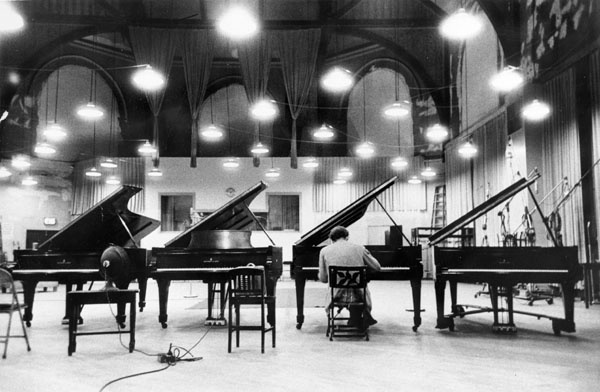 |
| Columbia Records’ 30th Street Studio |
Davis’ inaugural Columbia release is a highly consistent effort. On the album’s second tune, Miles takes Charlie Parker’s “Ah-Leu-Cha” at a faster tempo than the composer did on his own leisurely-paced 1948 recording (yet nowhere near as fast as Davis did at Newport in 1958), and though the leader opts for the bolder sound of an open horn here and on “Tadd’s Delight”, Davis’ signature muted trumpet sound dominates the album and is ultimately immortalized on ‘Round About Midnight. (It’s a shame that the quintet’s version of “Sweet Sue, Just You” didn’t make it to the original album release — a stellar take that could have only been left off as a practical matter of space — though fortunately it does appear on the 2001 Sony Legacy CD reissue.)
No sooner than alto saxophonist Julian “Cannonball” Adderley joined the group in early 1958 did Red Garland leave, unable to tolerate the leader’s sky-high standards. Jones would soon follow, and the First Great Quintet’s short reign would come to a close after the recording of Milestones. ‘Round About Midnight is thus one of the few examples of this iconic ensemble’s explosive power, and the album has stood the test of time as a rare combination of brilliance and accessibility equally fitting for attentive listening and unwinding.

